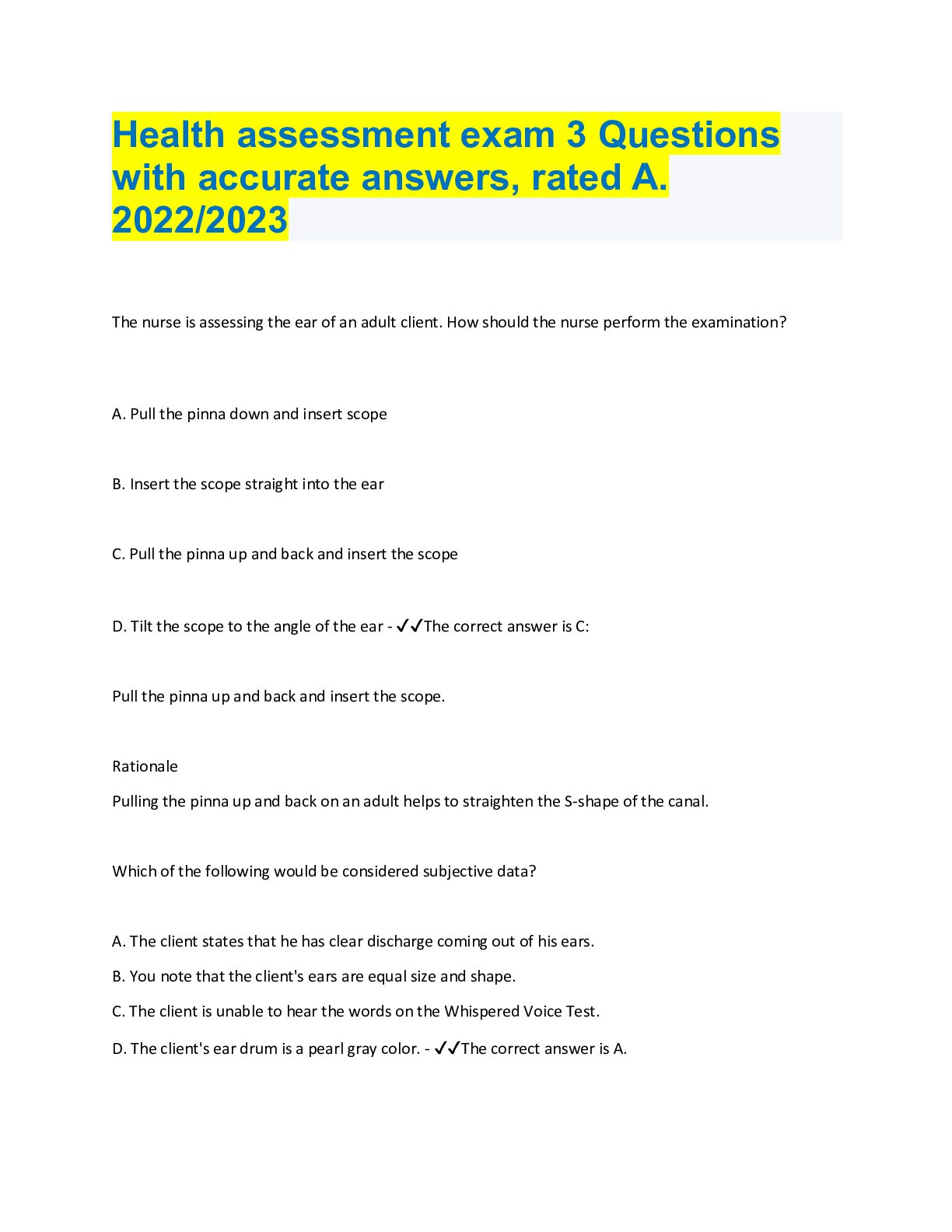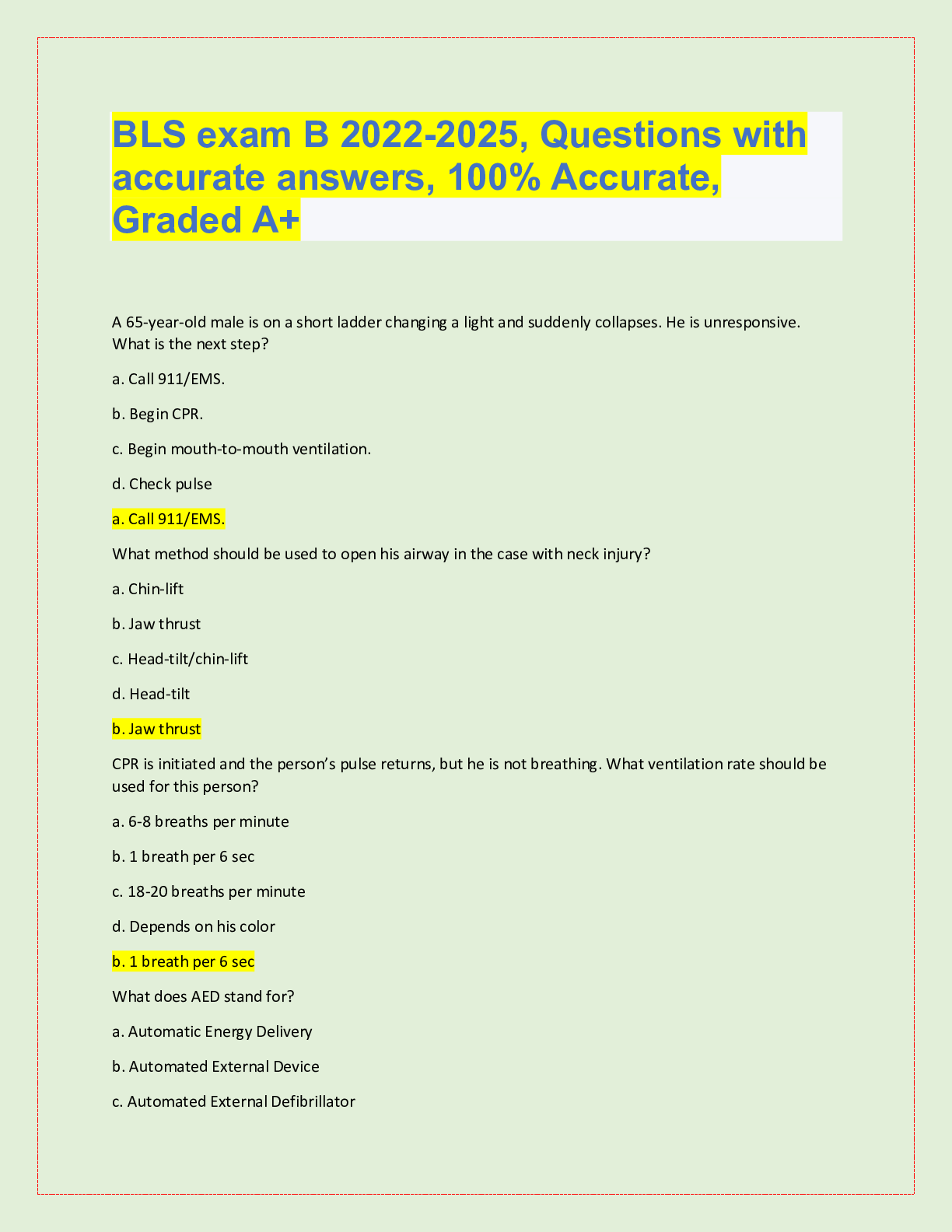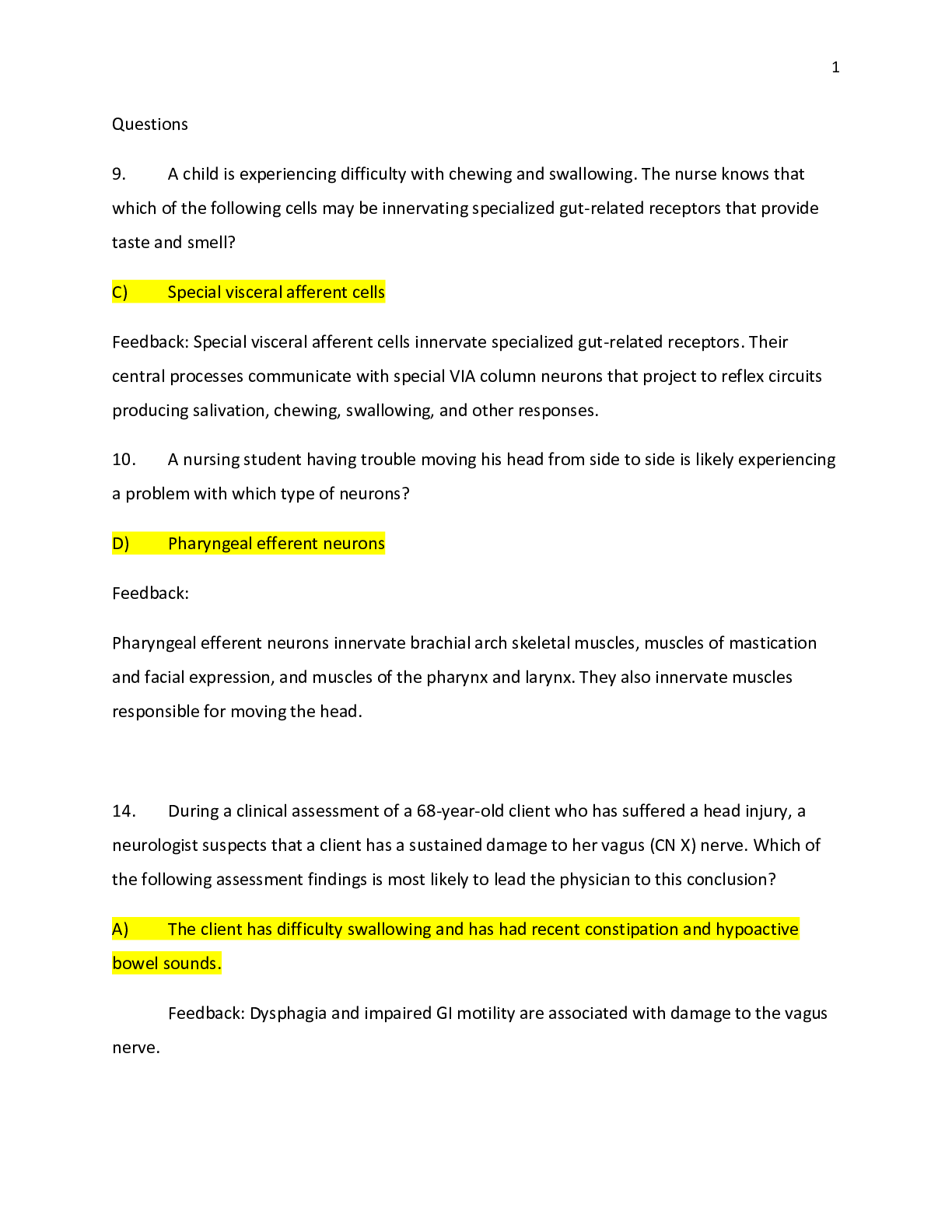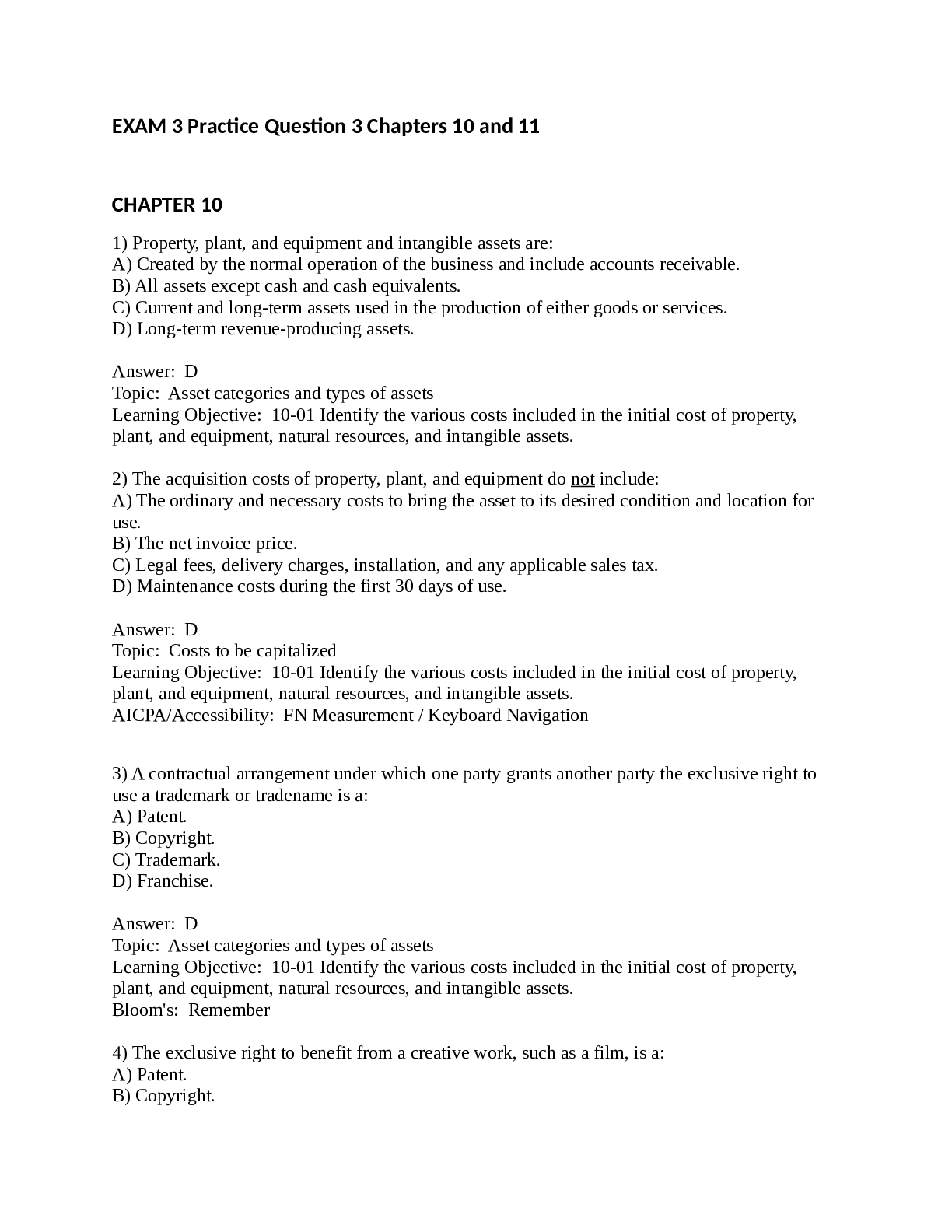*NURSING > QUESTIONS & ANSWERS > Health assessment exam 3 Questions with accurate answers, rated A. 2022/2023 (All)
Health assessment exam 3 Questions with accurate answers, rated A. 2022/2023
Document Content and Description Below
Health assessment exam 3 Questions with accurate answers, rated A. 2022/2023 The nurse is assessing the ear of an adult client. How should the nurse perform the examination? A. Pull the pinn... a down and insert scope B. Insert the scope straight into the ear C. Pull the pinna up and back and insert the scope D. Tilt the scope to the angle of the ear - ✔✔The correct answer is C: Pull the pinna up and back and insert the scope. Rationale Pulling the pinna up and back on an adult helps to straighten the S-shape of the canal. Which of the following would be considered subjective data? A. The client states that he has clear discharge coming out of his ears. B. You note that the client's ears are equal size and shape. C. The client is unable to hear the words on the Whispered Voice Test. D. The client's ear drum is a pearl gray color. - ✔✔The correct answer is A. The rest of the answers are objective data. The nurse is assessing a client who has a hearing impairment. How should the nurse communicate with this client? A) Use a low tone and speak slowly. B) Use a normal tone of voice and speak slowly. C) Speak loudly with a normal rate. D) Face the client and speak slowly. - ✔✔The correct answer is D: Face the client and speak slowly. Rationale When the client is able to see your face they are better able to understand you. Speaking slowly ensures that they are able to understand and can ask you to repeat when necessary. When examining the ear with an otoscope, the nurse notes that the tympanic membrane should appear: A) light pink with a slight bulge. B) pearly gray and slightly concave. C) pulled in at the base of the cone of light. D)whitish with a small fleck of light in the superior portion. - ✔✔ANS: B Rationale: The tympanic membrane is a translucent membrane with a pearly gray color and a prominent cone of light in the anteroinferior quadrant, which is the reflection of the otoscope light. The tympanic membrane is oval and slightly concave, pulled in at its center by the malleus, which is one of the middle ear ossicles. The nurse needs to pull the portion of the ear that consists of movable cartilage and skin down and back when administering eardrops. This portion of the ear is called the: A) auricle. B) concha. C) outer meatus. D)mastoid process. - ✔✔ANS: A Rationale The external ear is called the auricle or pinna and consists of movable cartilage and skin. A client with a middle ear infection asks the nurse, "What does the middle ear do?" The nurse responds by telling the client that the middle ear functions to: A) maintain balance. B) interpret sounds as they enter the ear. C) conduct vibrations of sounds to the inner ear. D) increase amplitude of sound for the inner ear to function. - ✔✔ANS: C Among its other functions, the middle ear conducts sound vibrations from the outer ear to the central hearing apparatus in the inner ear. The other responses are not functions of the middle ear. The nurse is assessing a client who may have hearing loss. Which of these statements is true concerning air conduction? A) It is the normal pathway for hearing. B) It is caused by the vibrations of bones in the skull. C) The amplitude of sound determines the pitch that is heard. D) A loss of air conduction is called a conductive hearing loss. - ✔✔ANS: A The normal pathway of hearing is air conduction, which starts when sound waves produce vibrations on the tympanic membrane. Conductive hearing loss results from a mechanical dysfunction of the external or middle ear. In performing a whispered words test to assess hearing, which of these actions would the nurse do? A) Shield the lips so that the sound is muffled. B) Whisper a set of random numbers and letters and ask the client to repeat them. C) Ask the client to cover both ears simultaneously to occlude outside noise. D)Stand about 4 feet away to ensure that the client can really hear at this distance. - ✔✔ANS: B With your head 30 to 60 cm (1 to 2 ft) from the person's ear, exhale and whisper slowly a set of random numbers and letters, such as "5, B, 6." Normally, the person repeats each number and letter correctly after you say it. The nurse is performing an ear examination of an 80-year-old client. Which of these would be considered a normal finding for the aging adult? A) A high-tone frequency loss B) Increased elasticity of the pinna C) A thin, translucent membrane D) A shiny, pink tympanic membrane - ✔✔ANS: A A high-tone frequency hearing loss is apparent for those affected with Presbycusis, the hearing loss that occurs with aging. The pinna loses elasticity, causing earlobes to be pendulous. The eardrum may be whiter in color and more opaque and duller than in the young adult. The nurse is examining a client's ears and notices cerumen in the external canal. Which of these statements about cerumen is correct? A) Sticky honey-colored cerumen is a sign of infection. B) The presence of cerumen is indicative of poor hygiene. C) The purpose of cerumen is to protect and lubricate the ear. D) Cerumen is necessary for transmitting sound through the auditory canal. - ✔✔ANS: C The ear is lined with glands that secrete cerumen, which is a yellow waxy material that lubricates and protects the ear. A client has been shown to have sensorineural hearing loss. During the assessment, it would be important for the nurse to: A) speak loudly so he can hear the questions. B) assess for middle ear infection as a possible cause. C) ask the client what medications he is currently taking. D) look for the source of the obstruction in the external ear. - ✔✔ANS: C A simple increase in amplitude may not enable the person to understand words. Sensorineural hearing loss may be caused by Presbycusis, which is a gradual nerve degeneration that occurs with aging and by ototoxic drugs, which affect the hair cells in the cochlea. The nurse is taking the history of a client who may have a perforated eardrum. What would be an important question in this situation? A) "Do you ever notice ringing or crackling in your ears?" B) "When was the last time you had your hearing checked?" C) "Have you ever been told you have any type of hearing loss?" D) "Was there any relationship between the ear pain and the discharge you mentioned?" - ✔✔ANS: D Typically with perforation, ear pain occurs first, stopping with a popping sensation, and then drainage occurs. An 18-year-old is at the clinic for "a sore throat lasting 6 days." The nurse is aware that which of these findings would be consistent with an acute infection? A) Tonsils 1+/1-4+ and pink, same color as oral mucosa B) Tonsils 2+/1-4+ with small plugs of white debris C) Tonsils 3+/1-4+ with large white spots D) Tonsils 3+/1-4+ with pale coloring - ✔✔ANS: C Rationale With an acute infection, tonsils are bright red and swollen and may have exudate or large white spots. Tonsils are enlarged to 2+, 3+, or 4+ with an acute infection. The salivary gland that is the largest and located in the cheek in front of the ear is the _____ gland. A) parotid B) Stensen's C) sublingual D) submandibular - ✔✔ANS: A The mouth contains three pairs of salivary glands. The largest, the parotid gland, lies within the cheeks in front of the ear extending from the zygomatic arch down to the angle of the jaw. Stensen's duct (not a gland) drains the parotid gland onto the buccal mucosa opposite the second molar. The sublingual gland is located within the floor of the mouth under the tongue. The submandibular gland lies beneath the mandible at the angle of the jaw. The nurse is assessing an 80-year-old client. Which of these findings would be expected for this client? A) Hypertrophy of the gums B) An increased production of saliva C) A decreased ability to identify odors D) Finer and less prominent nasal hair - ✔✔ANS: C The sense of smell may be reduced because of a decrease in the number of olfactory nerve fibers. Nasal hairs grow coarser and stiffer with aging. The gums may recede with aging, not hypertrophy, and there is a decrease in saliva production. A 92-year-old client has had a stroke. The right side of his face is drooping. The nurse might also suspect which of these assessment findings? A) Epistaxis B) Rhinorrhea C) Dysphagia D) Xerostomia - ✔✔ANS: C Dysphagia is difficulty with swallowing and may occur with a variety of disorders, including stroke and other neurologic diseases. Rhinorrhea is a runny nose; Epistaxis is a bloody nose. Xerostomia is a dry mouth. The nurse is doing an assessment on a 21-year-old client and notices that his nasal mucosa appears pale, gray, and swollen. What would be the most appropriate question to ask the client? A)"Are you aware of having any allergies?" B) "Do you have an elevated temperature?" C) "Have you had any symptoms of a cold?" D)"Have you been having frequent nosebleeds?" - ✔✔ANS: A With chronic allergy, mucosa looks swollen, boggy, pale, and gray. Elevated body temperature, colds, and nosebleeds do not cause these mucosal changes Which of these techniques best describes the test the nurse should use to assess the function of cranial nerve X (Vagus)? A)Observe the client's ability to articulate specific words. B)Observe the client's ability to move the shoulders against resistance. C)Have the client stick out the tongue and observe for tremors or pulling to one side. D)Ask the client to say "ahhh" and watch for movement of the soft palate and uvula. - ✔✔ANS: D Ask the person to say "ahhh" and note that the soft palate and uvula rise in the midline. This tests one function of CN X, the vagus nerve. Cranial nerve X (vagus) can also be tested by eliciting the gag reflex, as well as CN IX (glossopharyngeal). Cranial nerve XII (hypoglossal) is tested by asking the client to stick out his or her tongue and CN XI (spinal accessory) is tested by neck ROM and shoulder movement against resistance. The nurse is assessing a client in the hospital who has received numerous antibiotics and notices that his tongue appears to be black and hairy. In response to his concern, what would the nurse say? A)"We will need to get a biopsy and see what the cause is." B)"This is an overgrowth of hair and will go away in a few days." C)"This is a fungal infection caused by all the antibiotics you've received." D)"This is probably caused by the same bacteria you had in your lungs." - ✔✔ANS: C A black, hairy tongue is not really hair but the elongation of filiform papillae and painless overgrowth of mycelial threads of fungus infection on the tongue. It occurs after the use of antibiotics, which inhibit normal bacteria and allow proliferation of fungus. The primary purpose of the ciliated mucous membrane in the nose is to: A) warm the inhaled air. B) filter out dust and bacteria. C) filter coarse particles from inhaled air. D) facilitate movement of air through the nares. - ✔✔ANS: B The nasal hairs filter the coarsest matter from inhaled air, whereas the mucous blanket filters out dust and bacteria. The rich blood supply of the nasal mucosa warms the inhaled air. The nurse is palpating the sinus areas. If the findings are normal, then the client should report which sensation? A) No sensation B) Firm pressure C) Pain during palpation D) Pain sensation behind eyes - ✔✔ANS: B The person should feel firm pressure but no pain. Sinus areas are tender to palpation in persons with chronic allergies and acute infection (sinusitis). During an assessment of a 20-year-old client with a 3-day history of nausea and vomiting, the nurse notices dry mucosa and deep vertical fissures in the tongue. These findings are reflective of: A) dehydration. B) irritation by gastric juices. C) a normal oral assessment. D) side effects from nausea medication. - ✔✔ANS: A Dry mouth occurs with dehydration or fever. The tongue has deep vertical fissures. The two sinuses that can be directly palpated are? A. Frontal and Sphenoid B. Maxillary and Ethmoid C. Frontal and Maxillary D. Ethmoid and Sphenoid - ✔✔The correct answer is C: Frontal and Maxillary. The Ethmoid and Sphenoid sinuses are smaller and deeper and not accessible for examination. When assessing the teeth and gums, which of the following would be a normal finding? A. The teeth are white and the gums are coral pink B. The gums are bleeding C. The adult client has 22 total teeth D. The upper and lower jaw are not aligned - ✔✔The correct answer is A. The normal finding would be the teeth are white and the gums are coral pink. The other answers would be considered abnormal findings. The wife of a 65-year-old client tells the nurse that she is concerned because she has noticed a change in her husband's personality and ability to understand. He also cries and becomes angry very easily. The nurse recalls that the cerebral lobe responsible for these behaviors is the _____ lobe. A) frontal B) parietal C) occipital D) temporal - ✔✔correct answer is: A The frontal lobe has areas concerned with personality, behavior, emotions, and intellectual function. The parietal lobe has areas concerned with sensation; the occipital lobe is responsible for visual reception; and the temporal lobe is concerned with hearing, taste and smell. A CLIENT WAS ADMITTED TO THE ED WITH SLURRED SPEECH. THE NURSE NOTES THAT THIS COULD BE DUE TO DYSFUNCTION OF WHAT CRANIAL NERVE(S)? A) Cranial Nerve I B) Cranial Nerve V C) Cranial Nerves IX and X D) Cranial Nerve III - ✔✔Correct answer is c Cranial Nerve IX (Glossopharyngeal): Motor function controls phonation and swallowing Cranial Nerve X (Vagus): Motor function controls talking and swallowing The nurse is assessing a client who may have suffered a stroke. Which of these statements is true concerning areas of the brain? A) The cerebellum is the center for speech and emotions. B) The hypothalamus controls temperature and regulates sleep. C) The basal ganglia are responsible for controlling voluntary movements. D) Motor pathways of the spinal cord and brainstem synapse in the thalamus. - ✔✔Correct answer is b The hypothalamus is a vital area with many important functions: temperature controller, sleep center, anterior and posterior pituitary gland regulator, and coordinator of autonomic nervous system activity and emotional status. The cerebellum controls motor coordination, equilibrium, and balance. The basal ganglia controls autonomic movements of the body. The motor pathways of the spinal cord synapse in various areas of the spinal cord, not the thalamus. The nurse is testing the function of cranial nerve XI. Which of these best describes the response the nurse should expect if the nerve is intact? The client: A) demonstrates ability to hear normal conversation. B) sticks tongue out midline without tremors or deviation. C) follows an object with both eyes without nystagmus or strabismus. D) moves the head and shoulders against resistance with equal strength. - ✔✔Correct answer is d These are the expected normal findings when testing cranial nerve XI (spinal accessory nerve): The client should demonstrate the ability to rotate the head both ways forcibly against resistance applied to the side of the chin with equal strength and shrug the shoulders against resistance with equal strength on both sides. During the history, a client tells the nurse that "it feels like the room is spinning around me." The nurse would document this as: A) vertigo. B) syncope. C) dizziness. D) seizure activity. - ✔✔Correct answer is a True vertigo is rotational spinning caused by neurologic dysfunction or a problem in the vestibular apparatus or the vestibular nuclei in the brainstem. Dizziness is a lightheaded, swimming sensation. Syncope is a sudden loss of strength or a temporary loss of consciousness. Seizure activity is characterized by altered or loss of consciousness, involuntary muscle movements, and sensory disturbances. A female client is in the clinic with weakness in her left arm and leg that she has noticed for the past week. which type of neurologic examination would be most appropriate for this client? A) Glasgow Coma Scale B) Neurologic Recheck Examination C) Neurologic Screening Examination D) Complete Neurologic Examination - ✔✔Correct answer is d The nurse should perform a Complete Neurologic Examination on persons who have neurologic concerns (e.g., headache, weakness, loss of coordination) or who have shown signs of neurologic dysfunction. The Glasgow Coma Scale is used to define a person's level of consciousness. The Neurologic Recheck Examination is appropriate for persons with demonstrated [Show More]
Last updated: 2 years ago
Preview 1 out of 34 pages

Buy this document to get the full access instantly
Instant Download Access after purchase
Buy NowInstant download
We Accept:

Reviews( 0 )
$12.00
Can't find what you want? Try our AI powered Search
Document information
Connected school, study & course
About the document
Uploaded On
Oct 05, 2022
Number of pages
34
Written in
Additional information
This document has been written for:
Uploaded
Oct 05, 2022
Downloads
0
Views
103















.png)



.png)




